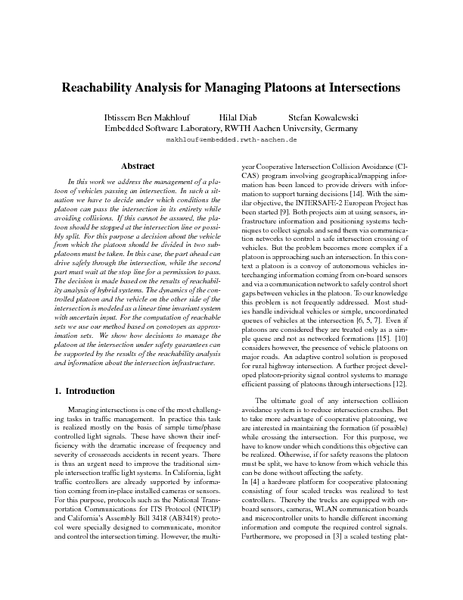Reachability Analysis for Managing Platoons at Intersections
In this work we address the management of a pla-toon of vehicles passing an intersection. In such a sit-uation we have to decide under which conditions theplatoon can pass the intersection in its entirety whileavoiding collisions. If this cannot be assured, the pla-toon should be stopped at the intersection line or possi-bly split. For this purpose a decision about the vehiclefrom which the platoon should be divided in two sub-platoons must be taken. In this case, the part ahead candrive safely through the intersection, while the secondpart must wait at the stop line for a permission to pass.The decision is made based on the results of reachabil-ity analysis of hybrid systems. The dynamics of the con-trolled platoon and the vehicle on the other side of theintersection is modeled as a linear time invariant systemwith uncertain input. For the computation of reachablesets we use our method based on zonotopes as approx-imation sets. We show how decisions to manage theplatoon at the intersection under safety guarantees canbe supported by the results of the reachability analysisand information about the intersection infrastructure. 1. Introduction Managing intersections is one of the most challeng-ing tasks in traf?c management. In practice this taskis realized mostly on the basis of simple time/phasecontrolled light signals. These have shown their inef-?ciency with the dramatic increase of frequency andseverity of crossroads accidents in recent years. Thereis thus an urgent need to improve the traditional sim-ple intersection traf?c light systems. In California, lighttraf?c controllers are already supported by informa-tion coming from in-place installed cameras or sensors.For this purpose, protocols such as the National Trans-portation Communications for ITS Protocol \NTCIP\and California?s Assembly Bill 3418 \AB3418\ proto-col were specially designed to communicate, monitorand control the intersection timing. However, the multi-year Cooperative Intersection Collision Avoidance \CI-CAS\ program involving geographical/mapping infor-mation has been lanced to provide drivers with infor-mation to support turning decisions [14]. With the sim-ilar objective, the INTERSAFE-2 European Project hasbeen started [9]. Both projects aim at using sensors, in-frastructure information and positioning systems tech-niques to collect signals and send them via communica-tion networks to control a safe intersection crossing ofvehicles. But the problem becomes more complex if aplatoon is approaching such an intersection. In this con-text a platoon is a convoy of autonomous vehicles in-terchanging information coming from on-board sensorsand via a communication network to safely control shortgaps between vehicles in the platoon. To our knowledgethis problem is not frequently addressed. Most stud-ies handle individual vehicles or simple, uncoordinatedqueues of vehicles at the intersection [6, 5, 7]. Even ifplatoons are considered they are treated only as a sim-ple queue and not as networked formations [15]. [10]considers however, the presence of vehicle platoons onmajor roads. An adaptive control solution is proposedfor rural highway intersection. A further project devel-oped platoon-priority signal control systems to manageef?cient passing of platoons through intersections [12].The ultimate goal of any intersection collisionavoidance system is to reduce intersection crashes. Butto take more advantage of cooperative platooning, weare interested in maintaining the formation \if possible\while crossing the intersection. For this purpose, wehave to know under which conditions this objective canbe realized. Otherwise, if for safety reasons the platoonmust be split, we have to know from which vehicle thiscan be done without affecting the safety.In [4] a hardware platform for cooperative platooningconsisting of four scaled trucks was realized to testcontrollers. Thereby the trucks are equipped with on-board sensors, cameras, WLAN communication boardsand microcontroller units to handle different incominginformation and compute the required control signals.Furthermore, we proposed in [3] a scaled testing plat-
